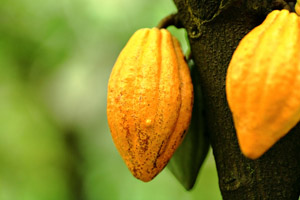Wild Chocolate

We found this long bridge that connected a rainforest community and consumers in the city,” says Alfonso Malky. “It was made of chocolate.”
In 2011, CSF’s Malky discovered a complex, but promising web of connections between economics, the environment, and the human condition when he created a market study for the Bolivian chocolate company Selva Cacao (“Jungle Chocolate”).
This story starts millions of years ago with the emergence of the cacao tree in South America’s rainforests. It was domesticated thousands of years ago and is now grown in vast plantations throughout the tropics. The stuff Selva Cacao uses, however, is still from wild trees in the Amazon Basin of Bolivia.
The company asked CSF to analyze the economic feasibility of employing indigenous forest populations to harvest wild cacao (“cacao” is a synonym for “cocoa”) and then make it into commercially viable chocolate bars. Malky began to ask questions. What were the benefits of wild cacao? How would villagers take to the opportunity? What makes for popular chocolate?
He discovered that harvesting wild cacao had multiple benefits. The bean grew without farmers having to resort to deforestation, soil abuse, or pesticides. Malky and other researchers also learned that villagers in communities like Carmen del Emero already knew how to collect the wild cacao beans. CSF proposed that Selva incentivize its potential workforce with a revenue-sharing model in which ten percent of all chocolate sales would go to the households involved in gathering wild cacao. Not only would the plan put extra money in people’s pockets—it would keep villagers from doing other work that might involve deforestation.
Then there was the matter of taste.
“We hosted focus groups, and people tried the wild chocolate side-by-side with products many considered some of the best chocolates on the market,” says Malky, describing the blind tests he ran. “The wild chocolate was always chosen first or second.”
Malky found that in the La Paz market brand loyalty was weak. Believing that there was room for a distinct (and only slightly more expensive) newcomer, he projected that Selva could sell 30,000 bars per month.
A year and a half later Malky sees Selva’s rainforest-sourced chocolate in stores all over town. It’s still a small business, but the chocolate bridge it built to the rainforest makes a real difference to people and their ability continue to coexist with the forest.
To read the study, click here: http://www.conservation-strategy.org/en/publication/del-cacao-silvestre-al-chocolate-una-propesta-de-mercado-para-comunidades-amaz%C3%B3nicas#.VibGZGSrRUQ
Photo Credit: Leung Chopan
---
Since 1998, Conservation Strategy Fund has been committed to making conservation efforts smarter through the use of economics. To celebrate, we're going to be sharing 15 stories of success throughout our history. The above is story #11 on our timeline. To start from the beginning, click here.
- Log in to post comments
